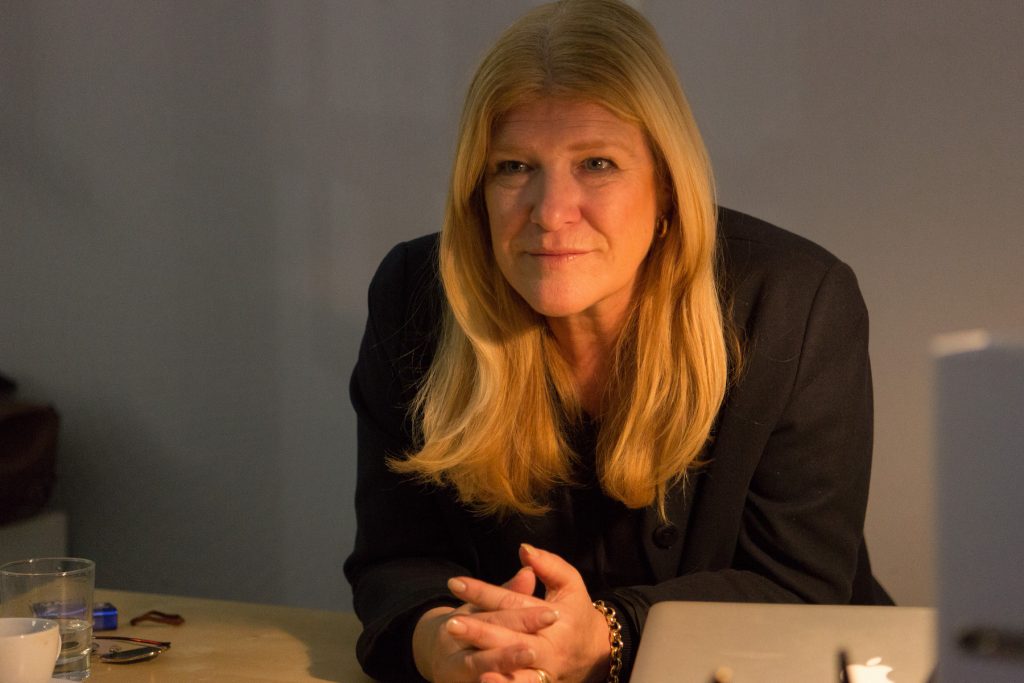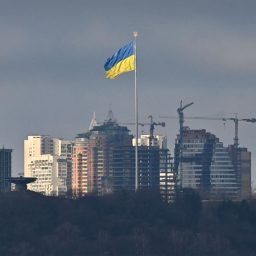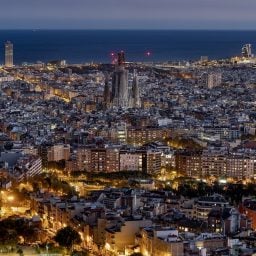Can a biennial transform a major city for the long haul?
Manifesta, Europe’s nomadic art biennial, is claiming that stake with its 2022 edition—Manifesta 14, which recently opened in the Kosovo capital of Prishtina. Under the guidance of founding director Dutch art historian Hedwig Fijen, Manifesta’s latest iteration aims to shine a light on Kosovo’s heterogenous and experimental art scene, not simply through temporary artist exhibitions but through long-term institutional and civic changes, made possible by years of cultural outreach and collaboration—a process Fijen calls one of “co-creation” between the biennial and the city’s residents.
During its 100-day run, Manifesta 14 will showcase wider efforts to reclaim public spaces throughout Prishtina. To help bring this to fruition, architect Carlo Ratti was brought on to conduct the “Urban Vision Project for the City of Prishtina,” a study focused on suggesting strategies to recoup spaces through a process that began with mapping the city, installing temporary and permanent urban interventions, and soliciting feedback from the public. This research helped to guide Catherine Nichols, the fair’s creative mediator, in developing a program of exhibitions and events that focus on storytelling through six avenues: radio, public art interventions, an eco-urban learning center, a main exhibition hall, guided walks, and the fair’s first permanent structure, the Centre for Narrative Practice.
We recently spoke with Fijen about how Manifesta continues to negotiate its purpose in the art world, what she means by co-creation, and why lasting change requires a democratic approach.
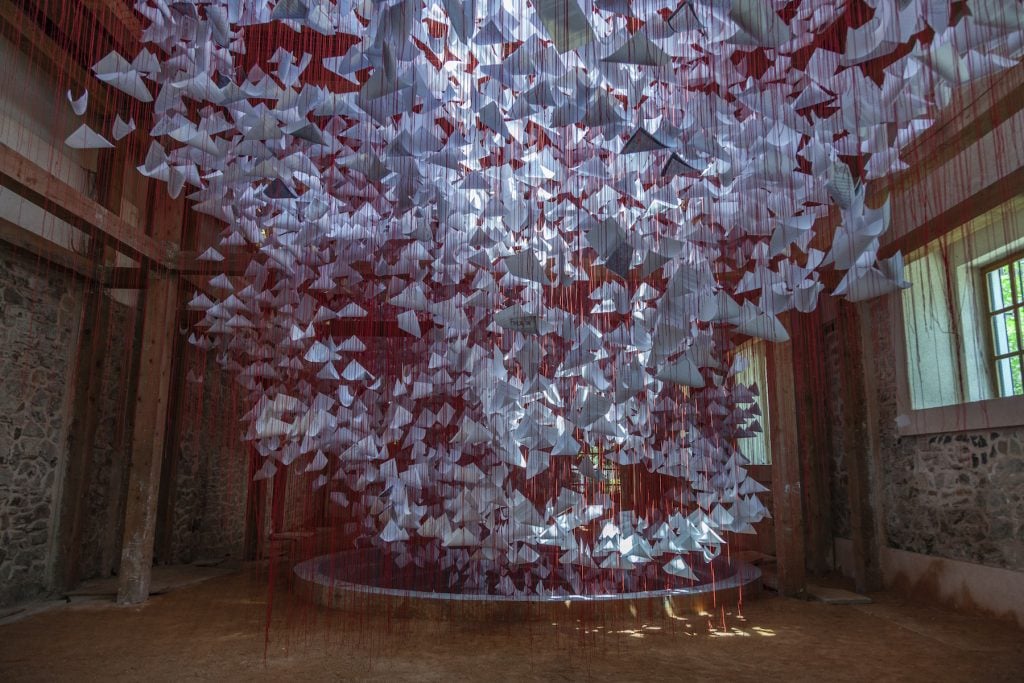
Chiharu Shiota, Tell me your Story (2022). Courtesy of Manifesta 14 Prishtina and Majlinda Hoxha.
Why Prishtina? What should people know about the city?
It was a very conscious decision to select Prishtina as the epicenter of Manifesta 14. Kosovo has one of the youngest populations in Europe, but its citizens remain isolated due to a strict visa regime. The selection is also as an attempt to help open up the cultural scene of Kosovo to Europe and the rest of the world.
In their bid to host the biennial, the City of Prishtina wrote to invite us. They asked us to reclaim public space, recreate a sense of collectivity, and rethink Prishtina’s future as an open-minded metropolis in the heart of the Balkans. As a nomadic biennial, we have the ambition to create an intercultural exchange, but strict visa restrictions mean that Kosovo’s cultural and artistic communities face the most basic obstructions, restricting their capacity to conduct and maintain constructive dialogues with Europe, let alone the rest of the world. We hope to create long-lasting connections that will continue to have an impact for decades to come.
Stimulating such intercultural dialogues has been core to all editions of Manifesta; for Manifesta 14 Prishtina, we knew that we wanted to raise the issue of how to grow and sustain cultural discussions and social debates and to open Europe and the world to Kosovo. We want the world to see and hear, loud and clear, all that the country has to offer, especially the energy of its younger generations. We hope Manifesta 14 Prishtina can generate cooperation and facilitate inclusive conversations around free travel in Europe and beyond.
Most of the galleries participating in this edition of Manifesta 14 are from Kosovo. What should people know about the art scene there that they might not be aware of?
There is a vibrant and exciting cultural scene here in Kosovo. Since our arrival, we have analyzed Prishtina from a range of unexpected perspectives, examining the city’s collective history and current challenges. As part of Manifesta 14’s pre-biennial program, we commissioned a study that resulted in an invaluable process of identifying and analyzing numerous crucial underground organizations. The study helped elucidate how these organizations came to be, the context in which they were developed, and how they continue to influence current practices.
In a region where archiving has often been absent, we created a “Mapping Subculture” publication, documenting the vibrant and multiple coexisting groups, individuals, and initiatives that have shaped the cultural identity of the cities of Prishtina, Skopje, and Tirana. The research for the publication was co-led by Termokiss, a social center founded in Prishtina in 2016 with the mission of urban and civil exchange, reflection, and change-making.
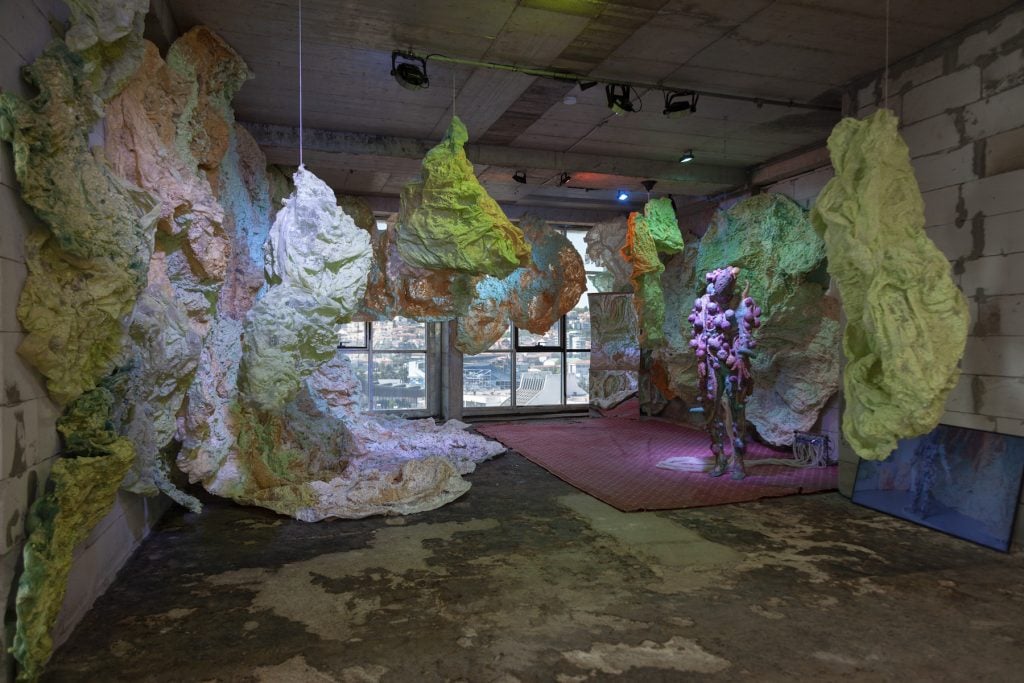
Mette Sterre, Seapussy Power Galore – Abcession (If you don’t know, you don’t grow) (2021–22). Courtesy of Manifesta 14 Prishtina and Majlinda Hoxha.
This edition of Manifesta will also highlight the Western Balkans more broadly. Can you tell us how?
Prishtina presents a unique location to look at the past and think about the present challenges Europe is facing. Beyond its physical location, Kosovo is manifested in a lively diaspora all around the world. Manifesta 14 has worked to create a regional parcours by connecting the Prishtina program to regional cultural partners throughout the Western Balkans. These connections will form a lasting network by setting up a system of regional solidarity. And, with the help of the E.U. and the United Nations Development Programme, we have been working closely with a different set of partners than usual, including urbanists, cultural professionals, activists, and thinkers to help develop culture as an economical force in Kosovo.
What do you see as the continuing, or possibly even growing, importance of the nomadic fair model?
Our nomadic role challenges us to look at the world through the eyes of our host cities, generating new visions and perspectives. One of our aims for Manifesta 14 was to bring international attention to national Kosovar talent. Therefore, for the first time, Manifesta has prompted the inclusion of noninstitutional and subcultural activists and artivist movements, which represent the bulk of Kosovar talent inside the biennial, alongside the institutions that define Prishtina’s rich and dynamic cultural ecosystem. This means that Kosovar participants are balanced equally with all other international partners and participants in the biennial.
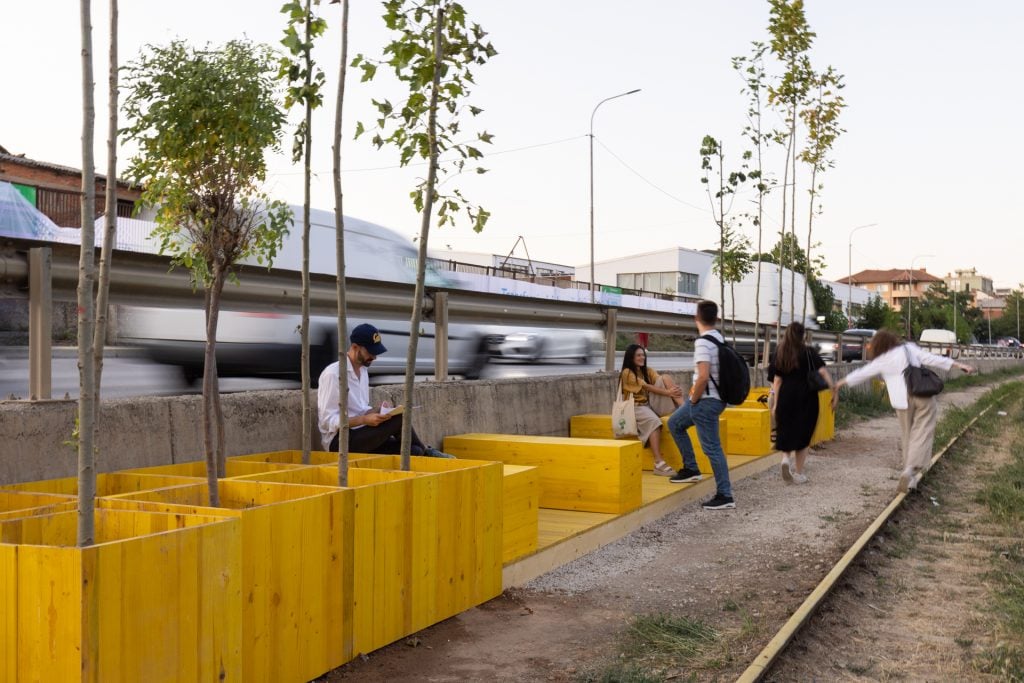
Carlo Ratti Associati, Green Corridor (2022). Courtesy of Manifesta 14 Prishtina and Ivan Erofeev.
Which presentations from this edition have you been particularly moved by?
The RomaMoMA with Farija Mehmeti comes to mind. The RomaMoMA Library was created in 2021 to commemorate the 50th anniversary of the First World Romani Congress. The library is dynamic and nomadic, engaging with local contexts wherever it travels. Comprising some 150 books on contemporary Roma literary, artistic, and cultural heritage, the growing collection showcases this rich Roma legacy, while critically interrogating the violence and oppression against the Roma in Europe. For its sojourn at the National Library of Kosovo, the RomaMoMA Library is accompanied by paintings by Farija Mehmeti, an artist renowned for her vibrant portraits of Roma women.
Another is Chiharu Shiota’s Tell me your Story, which explores the history of the Great Hammam of Prishtina. Built as a “couple hammam,” it dates back to the 15th century and was used by people of different genders for cleansing, relaxation, and socializing. One of the oldest and few remaining monuments in Prishtina’s cultural landscape, it has not been used as a hammam since 1960. Even in the absence of people, the building signifies a connection for Shiota. In Tell me your Story, the artist explores the threads that link us together, that bind us to other beings across space and time; for this installation, she has chosen to work with red yarn, a color she associates with blood, the body, and human relationships. Into the vast entanglement of what she describes as her “three-dimensional drawing,” the artist has woven personal stories of birth, childhood, family, country, religion, love, and death. Each was written by someone from Kosovo.
Lastly, it’s important to highlight that in our new Manifesta model, our presentations go beyond exhibitions or even artistic formats. The big change I introduced is that we are not focusing on temporary projects only (there will still be some exhibitions) but on developing together with the Kosovar team more long-term institutional changes, in which civil society is involved as well as the decision-makers to make sure they finally win the projects. An example is the Green Corridor, where we transformed a part of the disused Prishtina–Belgrade railway into a green space and pedestrian path. The local community is involved in the planting, design, and maintenance of this corridor, which will foster environmental change in a city with a lack of public and green spaces.
How has Manifesta’s mission changed or developed over the years?
In a world facing both growing inflation and a cruel invasion, Manifesta has rethought the biennial on several levels: changing our methodology from top-down to participatory; moving beyond the notion of an art biennial to generate legacy and impact through permanent transformations. I felt we had to question how we could become more relevant and how we could truly learn from Manifesta editions in the past. A key moment in our history was when preparing for Manifesta 12 in Palermo, the city’s anti-Mafia mayor, Leoluca Orlando, asked us to help his citizens reclaim their city, which was decaying under criminal and corrupt systems and needed a revitalization. I felt our model, as a traveling organization commissioning art and mediation, was not equipped to handle such an intricate request. In response, I pushed to transform Manifesta from a series of art exhibitions into a far more interdisciplinary, knowledge-and-research-producing platform involving citizens, activists, and learning institutions focused on urban transformation.
We call this transformation “from signals to substance.” But showing social transformation is not enough. What we learned is to work together with the public and civil society and makers to implement changes. In Prishtina, we worked on co-creating relevant sustainable artistic solutions to increase creative capacity, such as establishing a mediation school, creating a making space for artists, and launching an innovation platform.
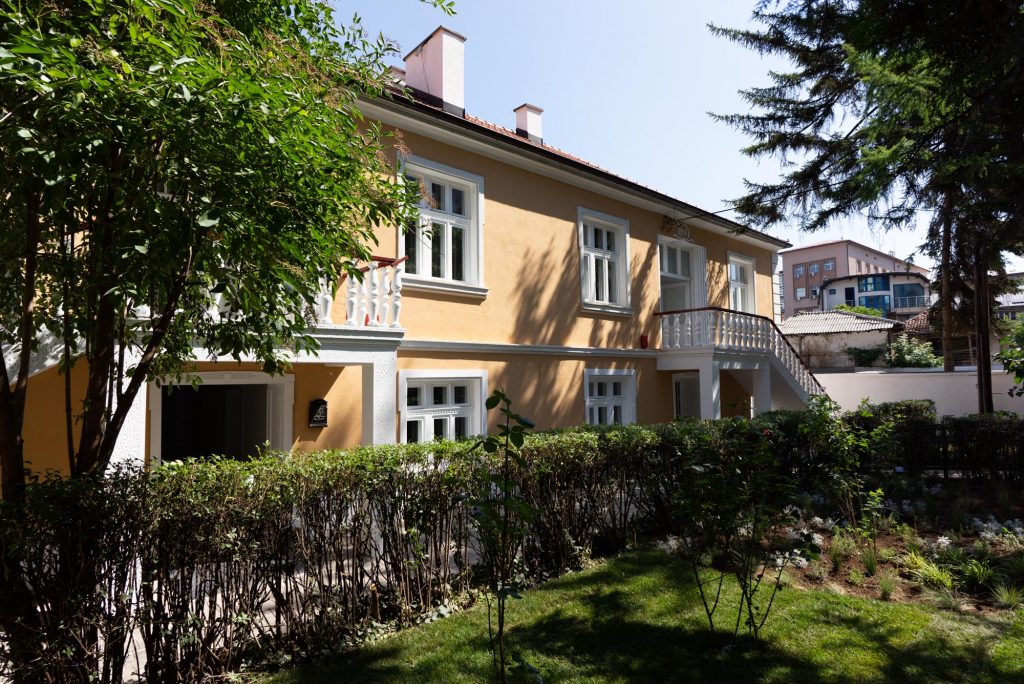
The Centre for Narrative Practice, 2022. Courtesy of Manifesta 14 Prishtina and Esad Duraki.
This year’s biennial will be leaving behind a permanent structure for the first time, too?
Because of the current geopolitical shift, the moment has come to construct a permanent, multifunctional structure. Telling stories, co-creation, and education will be the guiding principles at the Centre for Narrative Practice, which encompasses a making space, an urban garden, and a mediation school. The Centre will be secured for the next five years as a public-private collaboration. Everything we’ve developed for Prishtina has involved a model of direct democracy through citizen consultations and urban interventions to make sure we transformed the biennial into a participatory and collaborative catalyst for social change.
Manifesta 14 is open in Prishtina throughout the city until October 30, 2022. Learn more here.
